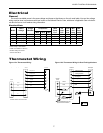
3
NS SPLIT INSTALLATION MANUAL
Installing and servicing heating and air conditioning equipment can be hazardous due to system pressure and electri-
cal components. Only trained and qualied service personnel should install, repair or service heating and air conditioning
equipment. Untrained personnel can perform the basic maintenance functions of cleaning coils and cleaning and replacing
lters. All other operations should be performed by trained service personnel. When working on heating and air conditioning
equipment, observe precautions in the literature, tags and labels attached to the unit and other safety precautions that may
apply, such as the following safety measures:
Follow all safety codes.
Wear safety glasses and work gloves.
Use a quenching cloth for brazing operations.
Have a re extinguisher available for all brazing operations.
Moving and Storage
Move units in the normal “up” orientation. Units may be moved and stored per the information on the packaging. Do not
stack more than three units in total height. Do not attempt to move units while stacked. When the equipment is received, all
items should be carefully checked against the bill of lading to be sure all crates and cartons have been received. Examine
units for shipping damage, removing the units from the packaging if necessary. Units in question should also be internally
inspected. If any damage is noted, the carrier should make the proper notation on the delivery receipt, acknowledging the
damage.
Split Unit Location
Locate the split compressor section away from areas that may disturb the customer and in a way that allows easy re-
moval of the access panels and the top of the cabinet. Provide sufcient room to make water, electrical and refrigerant line
connections and allow space for service personnel to perform maintenance. The NS split is approved for outdoor installation
when properly installed.
Air Coil Location
Refer to the air handler manufacturer’s instructions for the blower coil unit for details on installing the air handling portion
of the system.
Condensate Drain
Follow the blower coil manufacturer’s instructions.
Duct System
All blower coil units/air coils must be installed as specied by the manufacturer’s installation instructions; however, the
following recommendations should considered to minimize noise and service problems.
An air lter must always be installed upstream of the air coil on the return air side of the air handler or furnace. If there
is limited access to the lter rack for normal maintenance, it is suggested that a return air lter grill be installed. Be sure that
the return duct is properly installed and free of leaks to prevent dirt and debris from bypassing the lter and plugging the air
coil.
In applications using galvanized metal ductwork, a exible duct connector is recommended on both the supply and
return air plenums to minimize vibration from the blower. To maximize sound attenuation of the unit blower, the supply and
return plenums should include an internal duct liner of 1-inch thick glass ber or be constructed of ductboard. Insulation is
usually not installed in the supply branch ducts. Ducts in unconditioned areas should be wrapped with a minimum of 1-inch
duct insulation. Application of the unit to uninsulated ductwork in an unconditioned space is not recommended as the unit’s
performance will be adversely affected. If the air handler is connected to existing ductwork, a previous check should have
•
•
•
•
WARNING: Before performing service or maintenance operations on a system, turn off main power
switches to both units. Turn off accessory heater power switch if applicable. Electrical shock
could cause personal injury. Installing and servicing heating and air conditioning equipment can
be hazardous due to system pressure and electrical components. Only trained and qualied ser-
vice personnel should install, repair or service heating and air conditioning equipment.
Safety Considerations
General Installation Information


















